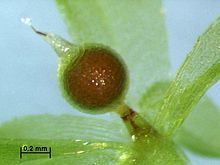Sporophyte

In plants and most algae, the sporophyte is the diploid generation (with a double set of chromosomes ) in the context of the heterophasic generation change . After a reduction division ( meiosis ), sporophytes produce haploid spores (with a single set of chromosomes), from which the haploid gametophyte generation emerges. Living beings with a heterophasic generation change (change of diploid and haploid generations) are called diplohaplons (detailed representation there).
In most plants, sporophytes and gametophytes can be clearly distinguished from one another (heteromorphic generation change). In seed plants , the sporophyte is much larger and more complex ( tree , shrub , herbaceous plant ) than the gametophyte. The spores are not released here, but remain in the mother plant and develop into a pollen grain (male gametophyte) or an embryo sac (female gametophyte). In the ferns , too , the sporophyte is the actual plant, while the gametophyte grows as a small prothallium on the ground. Conversely, in mosses the green moss plant is the gametophyte, while the sporophyte usually only consists of the spore capsule and its stem (the seta ). This is fed here by the gametophyte.
In many algae, the sporophytes and gametophytes look the same (isomorphic generation change).
literature
- P. Sitte, EW Weiler, JW Kadereit, A. Bresinsky, C. Körner: Strasburger Textbook of Botany , ISBN 3-8274-1388-5 .